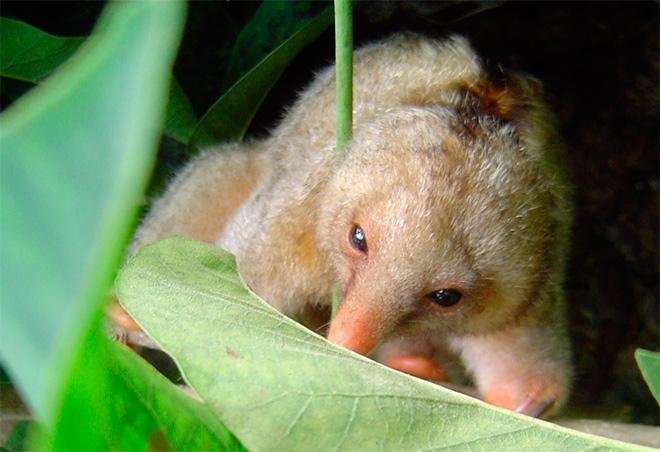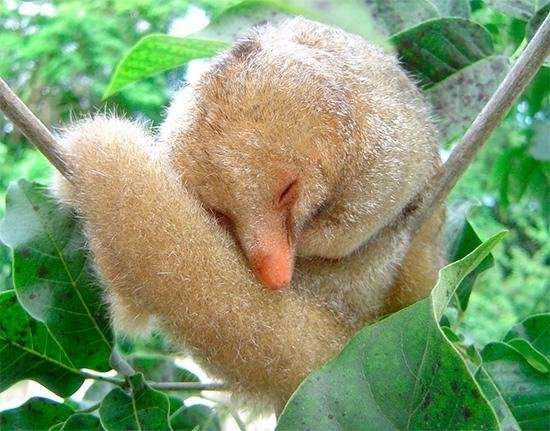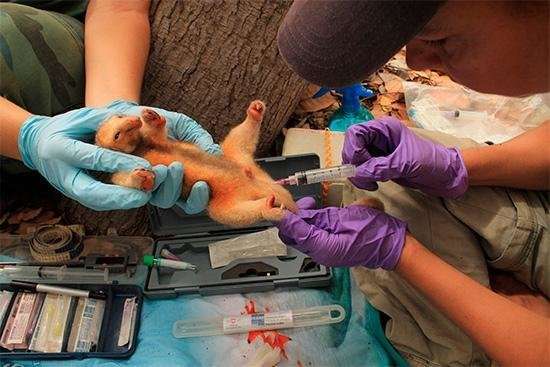Brazilian study discovers six new species of silky antieaters

Since the pioneering description made in 1758 by Swedish naturalist and father of taxonomy Carl Nilsson Linnaeus (1707-1778), there was officially one single silky anteater species. This short-snouted, pigmy-sized anteater would then be known for its scientific name, Cyclopes didactyla, after its inclusion in the 10th edition of Systema Naturae, Linnaeus' magnum opus. It is found in tropical forests in South and Central America, as well as in the few remaining fragments of Atlantic rainforest in Northeast Brazil.
Six populations of C. didactylus scattered through this territory were discovered in the 19th and early 20th centuries. However, because all the collected specimens appeared to be identical, it was thought that the subtle morphological differences could only justify the creation of subspecies of C. didactylus, therefore, the only species in the family Cyclopedidae.
But now, a Brazilian group of taxonomists, zoologists and geneticists proposes that silky anteaters comprise at least seven distinct species, after concluding a study of the biology and ecology of the new species, during which they sequenced mitochondrial and nuclear DNA from 287 specimens. They have published their results in the Zoological Journal of the Linnean Society.
Among the researchers waas Flávia Miranda, a Zoology Ph.D. student at UFMG who has worked with the order Xenarthra for over 20 years and leads Project Anteater, whose mission is the conservation of sloths, anteaters and armadillos. In 2005, Miranda took part in a meeting of the International Union for Conservation of Nature (IUCN) to verify the status of C. didactylus with a view to its conservation. One of the points raised was whether a population of silky anteaters still existed in Northeast Brazil. No sightings had been reported for years.
Miranda spent the next 10 years organizing and undertaking expeditions to all parts of Brazil where they had been reported. There have been 10 expeditions to Santa Isabel do Rio Negro (Amazonas State), Oriximiná (Pará), the Parnaíba River Delta (Piauí State), Maranhão, Amapá, and Surinam, among other places.
"It was always very hard to spot the animals in the forest. Imagine a little creature that weighs only 250 g, lives in the crowns of tall trees beside creeks or in mangroves and flooded areas, never comes down to the ground, never vocalizes, and is active only at night. I'd been in the field for two years before I made my first sighting," she says.

Miranda undertook 17 expeditions to collect specimens in Brazil and Surinam, measuring and photographing them, and taking blood samples for molecular analysis and recording sex and geographic location. She determined their ages on the basis of body mass, fur density, and fur length. She sought morphological and morphometric information from 20 natural history collections in several countries.
Analysis of the animals' nuclear and mitochondrial DNA removed all doubt about the existence of several species in the genus Cyclopes, supported by morphological and morphometric differences, as well as geographic location. The most surprising discoveries came from analysis using the molecular clock technique, which estimates when two species diverged on the basis of the number of molecular differences in their DNA.
The molecular clock showed that the separation of several species is quite ancient. The authors estimate that the Cyclopedidae diverged from other anteaters in the early Oligocene, 30 million years ago, giving rise to the giant anteater, Myrmecophaga tridactyla, and the collared anteater, Tamandua tetradactyla. Molecular evidence suggests the first divergence in the genus Cyclopes occurred 10.3 million years ago, during the late Miocene. This was when the ancestors of the lineages found west of Amazonas State, Acre and Rondônia States and also in the Peruvian Amazon separated.
This diversification is probably associated with a change in the course of the Amazon River, which once ran from east to west, but reversed direction approximately 10 million years ago, when the Andes rose. An immense floodplain formed at that time in western Amazonia.
The wetlands disappeared approximately 7 million years ago, isolating there the ancestors of two new species now described, C. rufus and C. thomasi. These may have separated 3.4 million years ago owing to the formation of the Purus and Madeira Basins, which functioned as biogeographic barriers that isolated the two populations. The Bolivian species C. catellus may also have emerged as a result of the same events.
The researchers estimate that C. ida diverged approximately 5.8 million years ago in the western Amazon and Ecuador, while C. xinguensis probably separated 4.6 million years ago in the area of the Xingu River, to which it has remained confined.
The Mesoamerican lineage C. dorsalis would have separated from its South American kin approximately 3 million years ago, with the continuing rise of the Andean barrier.

The species originally described by Linnaeus, C. didactylus, which lives on the left bank of the Amazon (and in the Negro River basin), in the Brazilian states of Amapá and Pará and also in Northeast Brazil from Maranhão to Alagoas (as well as in Venezuela and Surinam), is thought to have diverged some 2.3 million years ago, with the advent of the first glaciations of the Pleistocene.
So many millions of years of separation between species would be more than sufficient for these anteaters to have accumulated various modifications. However, this is not what has happened. The genus Cyclopes has proved extremely conservative throughout its evolutionary history, changing very little or not all in morphological terms.
"The reason for this may be the life habits of these animals. All species occupy a similar and highly specialized ecological niche with no competition," Miranda said.
While molecular evidence is definitive for the naming of new species, the analysis of morphological and ecological data is important to corroborate the descriptions. "Historically, this genus has always been considered monospecific," explained zoologist Fabio de Andrade Machado, currently at the Bernardo Rivadavia Natural Science Museum in Buenos Aires, Argentina.
Machado specializes in analyzing morphometric traits that differentiate species. In this project, he helped diagnose morphometric differences in search of evidence to confirm the descriptions of new species. "I used a technique called geometric morphometrics," he said. "It's based on multivariate analysis of point sets, or anatomical marks, which are used to map the shapes of biological structures. This technique can be used to investigate overall skull structure and identify general differences between species in terms of form."
According to Machado, this analysis showed that the main difference in the species studied referred to the Mesoamerican taxon (C. dorsalis), which has a smaller rostrum (snout) than the other South American groups.
Another conclusion was that the animals from the Northeast of Brazil, French Guiana (C. didactylus) and Xingu (C. xinguensis) have a slimmer, less robust skull than the rest. "Despite the lack of a precise diagnosis, as in the case of C. dorsalis, this suggests there are more than one or two species in the genus," Machado said.
More information: Flávia R Miranda et al, Taxonomic review of the genus Cyclopes Gray, 1821 (Xenarthra: Pilosa), with the revalidation and description of new species, Zoological Journal of the Linnean Society (2017). DOI: 10.1093/zoolinnean/zlx079
Journal information: Zoological Journal of the Linnean Society
Provided by FAPESP



















